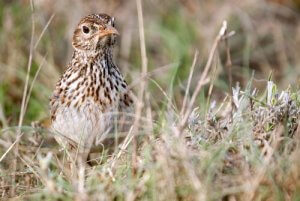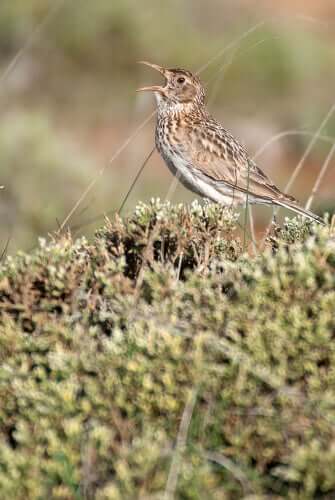Dupont's Lark: Conservation of the Species


Written and verified by biochemistry Luz Eduviges Thomas-Romero
The lark is one of many birds found all throughout southern Spain and northern Africa. The biggest characteristic of a Dupont’s lark is that they make their nests on the ground. This is because they mostly move around close to it. Also, they have cryptic camouflage, most likely to blend with their surroundings.
Almost the entire European population of Dupont’s lark (Chersophilus duponti) lives in Spain. Notable authors such as Chaucer and Shakespeare even highlighted this little bird in their literature. This was largely due to the bird’s morning song as it symbolized dawn throughout their work. In this article, we’ll get to know a little about the life of this little singer and the danger it currently faces.
Characteristics of a lark
The Dupont’s lark is a member of the bird family Alaudidae, which in turn belongs to the passerines or songbirds. They’re small in size, about 4.3 inches. This, together with its brownish plumage, helps them go unnoticed.
In fact, their camouflage is so good that birdwatchers know it as “the ghost of the moor.” The lark prefers open spaces and large plains, in arid and semi-arid environments.
You can find it mainly in the Layna moor or in the Ebro valley in Spain. But also in Rincón de Ademuz and wherever patches of rosemary (Rosmarinus officinalis) are located.
A notable singer

The lark is a morning singer; it mostly sings in the hour prior to dawn. Its trill is very melodious and it performs it with great intensity. The varied vocalization includes alarms and stress calls, but the lark mostly uses it for its detection and territorial claims.
Males sing while flying, and thereby defend their breeding territories and attract their partners. However, there are reports of singing females in other lark species. There’s no evidence that Dupont’s lark females sing.
Dupont’s lark – nutrition
This little bird is omnivorous and feeds when on the ground. Insects are their favorite food and they eat a wide variety of them. They also eat seeds, grasses, leaves, buds, fruits, and flowers.
Nesting and reproductive biology
As we mentioned before, the Dupont’s larks build their nests on the ground. They make their nests in such a way that thicket, tufts of grass, lumps of earth, or stones are all they need for protection. The nest is usually cup-shaped.
As for the number of eggs they lay, researchers know they range from three to five and that the female incubates them all by herself. Even though there’s limited information on incubation, we do know it lasts around 12 days. In addition, chicks leave the nest after a period of 8 days.
The breeding season of this species begins at the end of March and lasts until the beginning of July. These birds remain in their breeding areas for an entire year.
It’s interesting to know that the predation rate for this species (the occurrence of a predator attacking their nests) ranges between 46% and 84%.
The Dupont’s lark is endangered

This bird species has had a population decline of 4% per year for at least the last 10 years, so it is a high-priority animal, and is classified as an endangered species. The criteria used for the classification include the population size and the area of its distribution.
Thus, the classification of Dupont’s lark is due to the fact that the area of its occupation area is less than 193 sq. miles. In addition, its population is very fragmented, since most individuals are distributed in about 14 locations.
Additionally, it’s classified as a vulnerable species and at the European level, it’s included in Annex I of the Birds Directive (Dir. 79/409 / EEC) as a species subject to conservation measures.
Why is the Dupont’s lark endangered?

Experts believe that steppe birds are the most threatened group and have the highest risk of disappearing in the coming decades. Among them, Dupont’s lark is the bird that’s declining the most in its natural habitat.
It’s undeniable how many more unfavorable conditions are appearing as a result of climate change. Food shortages and habitat loss are some of the other causes of equal importance.
The lark depends on open, dry and warm areas with low and uneven vegetation. There aren’t many of those niches left in the cultural landscape of Central Europe. Human activity, through agricultural intensification, modified the Dupont’s lark’s habitats. And, as a consequence, the steppe is now deteriorated and there’s less of it.
The sharp decline of the Dupont’s lark’s population has raised red flags about the urgent need to develop a national conservation strategy. The strategy includes measures to protect populations and ensure their long-term viability.
The Dupont’s lark’s conservation strategy includes protecting the areas where the species live. All while avoiding a more negative impact on these areas and managing their habitat. In addition, it’s essential to execute a monitoring program based on effective population census methods.
Habitat management, unavoidable obligation
Experts feel they have the duty to protect, as far as possible, a series of places of potential habitat that could act as natural corridors among the remaining populations – all to allow recolonization events to occur.
Experts estimate that 494 acres are the minimum desirable extension for habitat spots to host Dupont’s lark populations. Recently, the situation of this bird in danger of extinction improved due to a government program of research and conservation of the species.
The lark is one of many birds found all throughout southern Spain and northern Africa. The biggest characteristic of a Dupont’s lark is that they make their nests on the ground. This is because they mostly move around close to it. Also, they have cryptic camouflage, most likely to blend with their surroundings.
Almost the entire European population of Dupont’s lark (Chersophilus duponti) lives in Spain. Notable authors such as Chaucer and Shakespeare even highlighted this little bird in their literature. This was largely due to the bird’s morning song as it symbolized dawn throughout their work. In this article, we’ll get to know a little about the life of this little singer and the danger it currently faces.
Characteristics of a lark
The Dupont’s lark is a member of the bird family Alaudidae, which in turn belongs to the passerines or songbirds. They’re small in size, about 4.3 inches. This, together with its brownish plumage, helps them go unnoticed.
In fact, their camouflage is so good that birdwatchers know it as “the ghost of the moor.” The lark prefers open spaces and large plains, in arid and semi-arid environments.
You can find it mainly in the Layna moor or in the Ebro valley in Spain. But also in Rincón de Ademuz and wherever patches of rosemary (Rosmarinus officinalis) are located.
A notable singer

The lark is a morning singer; it mostly sings in the hour prior to dawn. Its trill is very melodious and it performs it with great intensity. The varied vocalization includes alarms and stress calls, but the lark mostly uses it for its detection and territorial claims.
Males sing while flying, and thereby defend their breeding territories and attract their partners. However, there are reports of singing females in other lark species. There’s no evidence that Dupont’s lark females sing.
Dupont’s lark – nutrition
This little bird is omnivorous and feeds when on the ground. Insects are their favorite food and they eat a wide variety of them. They also eat seeds, grasses, leaves, buds, fruits, and flowers.
Nesting and reproductive biology
As we mentioned before, the Dupont’s larks build their nests on the ground. They make their nests in such a way that thicket, tufts of grass, lumps of earth, or stones are all they need for protection. The nest is usually cup-shaped.
As for the number of eggs they lay, researchers know they range from three to five and that the female incubates them all by herself. Even though there’s limited information on incubation, we do know it lasts around 12 days. In addition, chicks leave the nest after a period of 8 days.
The breeding season of this species begins at the end of March and lasts until the beginning of July. These birds remain in their breeding areas for an entire year.
It’s interesting to know that the predation rate for this species (the occurrence of a predator attacking their nests) ranges between 46% and 84%.
The Dupont’s lark is endangered

This bird species has had a population decline of 4% per year for at least the last 10 years, so it is a high-priority animal, and is classified as an endangered species. The criteria used for the classification include the population size and the area of its distribution.
Thus, the classification of Dupont’s lark is due to the fact that the area of its occupation area is less than 193 sq. miles. In addition, its population is very fragmented, since most individuals are distributed in about 14 locations.
Additionally, it’s classified as a vulnerable species and at the European level, it’s included in Annex I of the Birds Directive (Dir. 79/409 / EEC) as a species subject to conservation measures.
Why is the Dupont’s lark endangered?

Experts believe that steppe birds are the most threatened group and have the highest risk of disappearing in the coming decades. Among them, Dupont’s lark is the bird that’s declining the most in its natural habitat.
It’s undeniable how many more unfavorable conditions are appearing as a result of climate change. Food shortages and habitat loss are some of the other causes of equal importance.
The lark depends on open, dry and warm areas with low and uneven vegetation. There aren’t many of those niches left in the cultural landscape of Central Europe. Human activity, through agricultural intensification, modified the Dupont’s lark’s habitats. And, as a consequence, the steppe is now deteriorated and there’s less of it.
The sharp decline of the Dupont’s lark’s population has raised red flags about the urgent need to develop a national conservation strategy. The strategy includes measures to protect populations and ensure their long-term viability.
The Dupont’s lark’s conservation strategy includes protecting the areas where the species live. All while avoiding a more negative impact on these areas and managing their habitat. In addition, it’s essential to execute a monitoring program based on effective population census methods.
Habitat management, unavoidable obligation
Experts feel they have the duty to protect, as far as possible, a series of places of potential habitat that could act as natural corridors among the remaining populations – all to allow recolonization events to occur.
Experts estimate that 494 acres are the minimum desirable extension for habitat spots to host Dupont’s lark populations. Recently, the situation of this bird in danger of extinction improved due to a government program of research and conservation of the species.
All cited sources were thoroughly reviewed by our team to ensure their quality, reliability, currency, and validity. The bibliography of this article was considered reliable and of academic or scientific accuracy.
- Yanes, M., & Suarez, F. (1996). Incidental Nest Predation and Lark Conservation in an Iberian Semiarid Shrubsteppe. Conservation Biology, 10(3), 881-887.
- Rivas, J. M., & Moreno-Rueda, G. (2006). Censo detallado de la mayor población de Alondra Ricotí Chersophilus duponti del sur de España. Revista Catalana d’Ornitologia, 22, 27-29.
- Pérez Granados, C., Iborra, L., & Germán, M. (2018). Biología y conservación de la alondra ricotí Chersophilus duponti. Revista Catalana d’Ornitologia, 34: 33-54. doi:10.2436/20.8100.01.5
- Pérez-Contreras, J., González Cachinero, J.M. (2013). Rivas Fernández J. M. Inventario ornitológico de la provincia de Granada, España (2003-2012). Zool. baetica, 24: 79-139 ISSN: 1130-4251
This text is provided for informational purposes only and does not replace consultation with a professional. If in doubt, consult your specialist.








